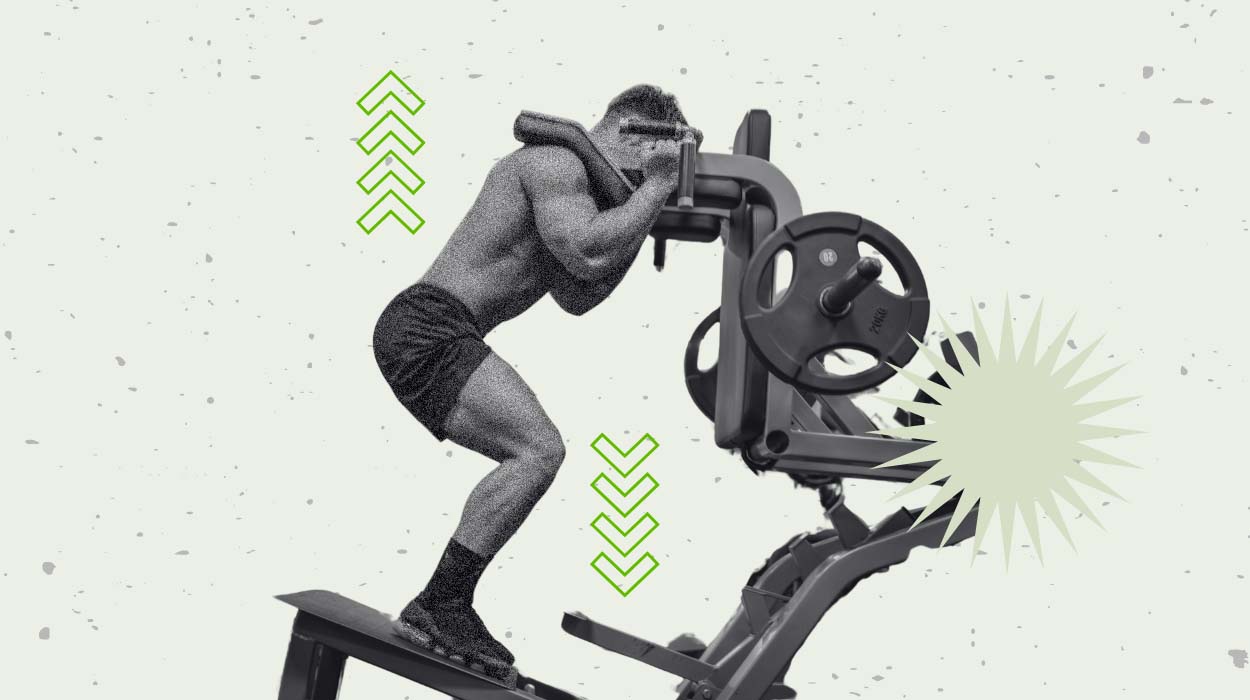
The hack squat is a machine-based exercise that involves leaning against an exercise board at a 45-degree angle. This exercise board is equipped with dual sleeves that can be loaded with free-weight squat plates. Another attachment of the exercise board is dual shoulder pads, which cushion the upper body during the movement.
Above the shoulder pads, we will find dual handles that can be gripped throughout the movement. This whole mechanism is hinged to the ramps of the hack squat.
On the opposite side of hack squat machines, there is a fixed platform to press your feet against. This will move the loaded exercise board, and create some muscle stimulus.
How To Do The Hack Squat
- Set up your hack squat.
- Get in position.
- Find your stance.
- Prepare your core.
- Unrack the weight.
- Perform the squat.
- Finish the rep.
How To Do The Hack Squat?
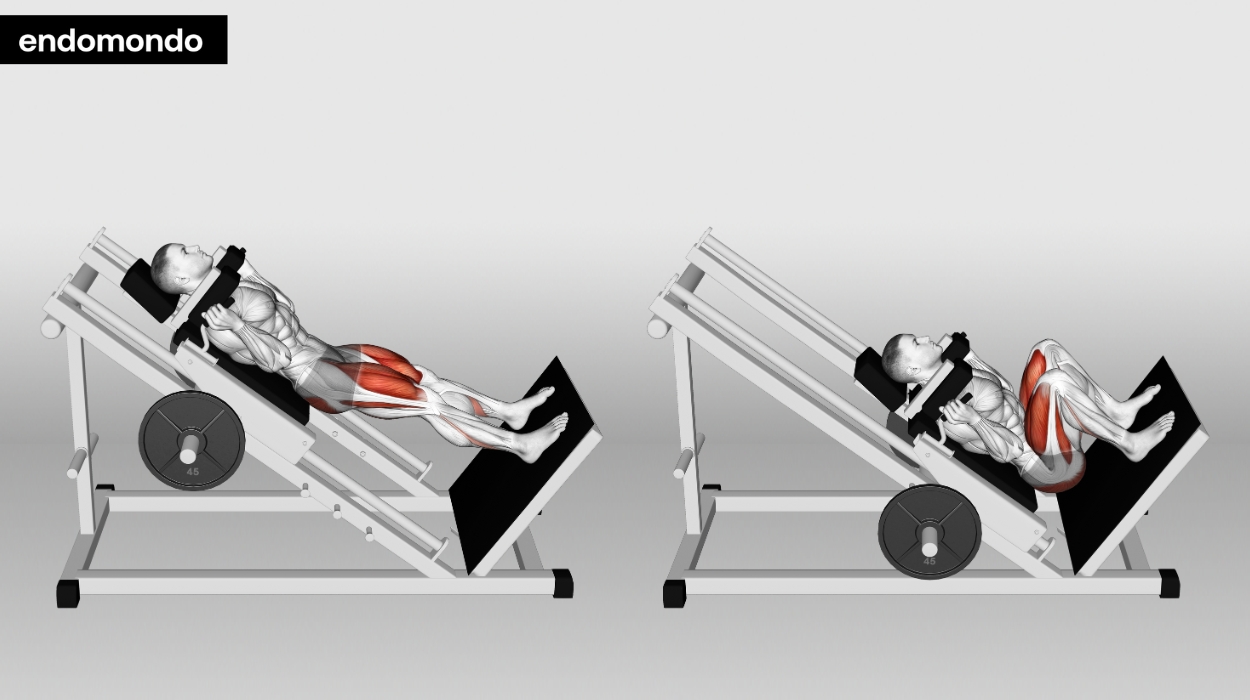
Set Up Your Hack Squat
- Adjust the hack squat machine to your desired depth.
- Load up the hack squat to your training level with weights on the sides. Be sure to place an even amount of weight on each side.
Get In Position
- Lay flat on your back on the hack squat exercise board so your shoulders rest on the shoulder pads.
- Grasp the hack squat handles.
Find Your Stance
- Place your feet shoulder-width apart with your feet pointed straight in front.
Prepare Your Core
- Engage the core by utilizing your exhale for the lifting portion of the motion.
Unrack The Weight
- When ready to begin, straighten at your knees to unrack the weight.
Perform The Squat
- Maintain an engaged core and shift the weight toward the back of your feet.
- Lower the weight by bending at the knees and hips to your full squat depth.
- Breathe in as you lower down.
Finish The Rep
- Begin your breath out and press push the weight up, extending at the knees and hips.
- Repeat the movement as needed for your workout.
ADDITIONAL INFORMATION: Some machines have safety clips to avoid movement of the weight when not prepared. Determine where the safety clips are before beginning the exercise to ensure understanding before using the machine.
Hack Squat Variations
Most weightlifting enthusiasts understand the importance of working every muscle to achieve a balanced workout. In addition to the standard leg day exercises, you should consider adding variations. For example, performing a front squat activates your quads more than a back squat because of the bar position.
Maximizing your lower body muscles through multiple exercise positions can lead to the results you want. Leg exercise variations provide different muscle engagement which is required for optimal aesthetic appearance and balanced strength. Options available to attain your quad, hamstring, and glute goals include landmine, barbell, and reverse hack squats.
Landmine Hack Squat
The hack squat is more favorable for people with ankle or knee mobility issues. One variation to the standard machine press is a landmine hack squat. A landmine squat requires a barbell attached to a base or secure place on the floor.
The weight plates for this exercise are added to the unattached end of the bar only. The bar will rest on top of one shoulder, so be attentive to switching shoulders for a balanced workout. Below are step-by-step instructions.
- Lift the bar from the floor to shoulder height, also known as a clean motion.
- Once lifted from the floor, turn your body so that your back is facing the landmine base.
- Rest the bar on one shoulder and hold it with two hands for security.
- Place your feet hip-width apart on the floor and a couple of steps in front of your body.
- Next, engage your core and squat down keeping your feet flat on the floor and pressing backward with your hips.
- Keep the chest upright while you squat until your thighs are parallel to the floor.
- Pause and then press up to stand.
- Rest before switching to the other shoulder, then repeat the steps.
Barbell Hack Squat
The barbell hack squat is a solid alternative if you do not have access to a hack machine. This lift is performed from the floor instead of having the weight resting on your shoulders. The bar is behind you which may be challenging if you have tight shoulders.
Using a barbell in this position allows you to work your grip strength and challenges your upright lifting form. This exercise is still quad-focused with secondary support of the gluteals, back, and calf muscles. Follow the steps below for optimal results.
- Stand with your feet hip-width apart and the barbell behind your feet on the floor.
- Squat to pick up the bar using a pronated or overhand grip.
- Inhale and engage your core as you stand lifting the bar.
- Focus on keeping the bar close to your body, your trunk upright, your back flat, and pressing through your heels to better engage your glutes.
- As you finish standing upright, engage your glutes and quads, pause then lower the bar to the floor.
- While returning to your starting point, be aware to pass through the same body positions as you lower the bar with control.
- Placing a plate under your heels supports folks with poor ankle and knee mobility.
Reverse Hack Squat
The reverse hack squat is performed using the machine, unlike a barbell back squat where your body is free-standing. The body position in this exercise option requires you to face the machine. Reversing the body puts more emphasis on the posterior chain muscles, such as the hamstrings and gluteals.
In the machine-facing position, your chest and shoulders press against the back and top pads. This variation requires an impeccable form to avoid or limit injury. We’ll review the ideal sequence of steps to ensure proper execution of the reverse hack squat.
- Adjust the machine for your preferred height and starting weight.
- Step onto the machine, turn facing the back pad and weights, and place your feet shoulder-width apart on the base or footplate. Your toes and knees should be facing slightly outward.
- Next, place your shoulders under the pads, chest on the pad, and grip the machine handles.
- Push the weight upward lifting it off the rack and lower yourself into a squat until your thighs are parallel to the footplate.
- Pause in the squat then press the weight upward to stand without locking out your knees.
- Focus on pressing through the feet and keeping your core engaged.
Hack Squat Alternatives To Try
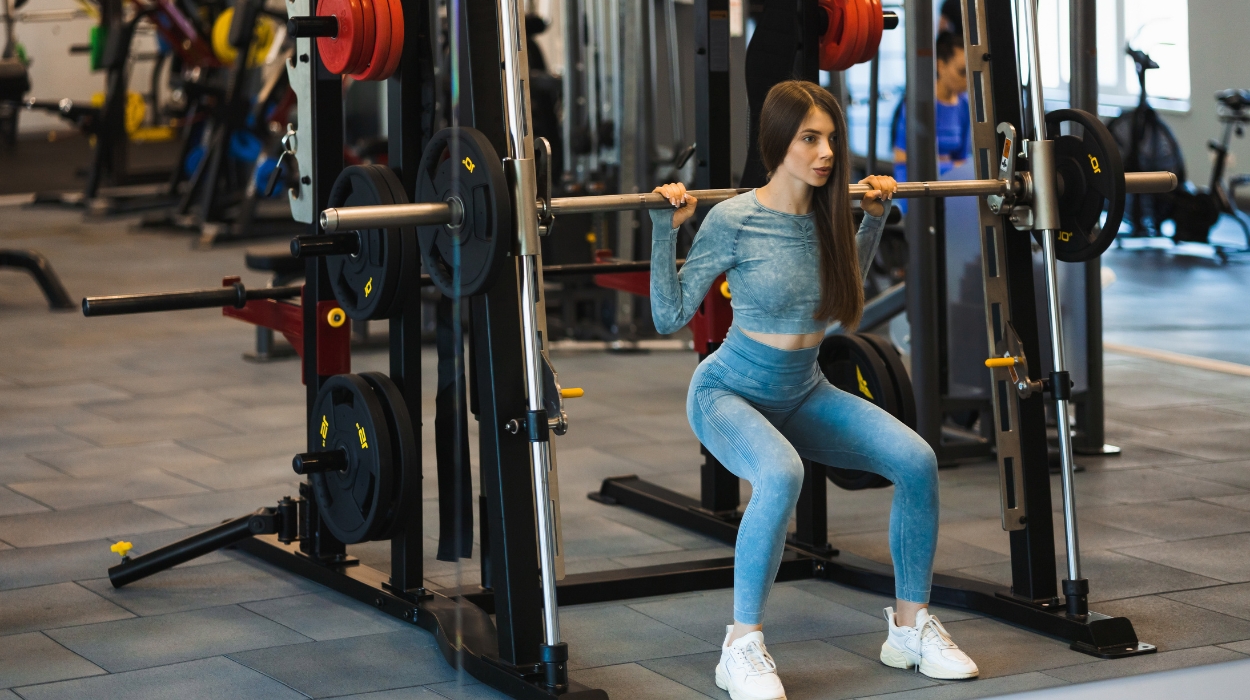
Squats are multi-muscle moves that can be done in many ways to change their focus. While the hack squat is an effective leg workout it may not work well for everyone. The barbell squat is a standard lower-body strength exercise with time-tested results.
Whether certain equipment is not available or you need new exercises to challenge your muscles, there are multiple options. If you are searching for some additional leg day options to reach your goals we can provide some suggestions. Sumo deadlifts, the leg press, and the Smith machine are all worthy additions to leg day.
Sumo Deadlifts
Sumo squats are aptly named because of their wide Sumo-like foot and leg positions. A sumo deadlift is performed in the same body position but resistance originates from a different direction. A deadlift requires that weight be lifted from the floor.
Deadlifts primarily activate the posterior chain muscles, the back, hamstrings, and glutes. Squats focus more on the quads and glutes, however, both exercises are effective in working the legs. Let’s discuss the details of proper technique while performing sumo deadlifts.
- Begin standing with your preferred weight and barbell on the floor in front of you.
- Step your feet apart to a wide stance with your toes pointed outward. The bar should be above the midfoot.
- Then hinge at your hips to lower down and grip the bar. Option to place one hand under grip and one hand over as this grip may provide increased security but is optional. An overhand or pronated grip for both hands is acceptable and per your preference.
- Inhale, then exhale while engaging your core and lift the bar off the floor to upright standing.
- Ensure you keep the bar close to your body, pause, and then lower the bar returning it to the floor hinging at your hips for glute activation. Repeat for your planned reps.
Leg Press Machine
This tried and true exercise may be the simplest for a weight-training newcomer. Most fitness centers and gyms have a leg press because it’s an effective but easy exercise to manage. Your body is supported throughout the exercise.
This machine works most of the leg. The focus muscles can be altered using different foot and leg positions. A variety of leg press machine styles are available, some contain weights and others require added plates.
Some are more reclined so that your legs press upward, and another is more upright where the legs press outward. There are also sled leg presses in which the back support moves instead of the leg plate and vertical leg presses as well. Depending on which option suits your individual needs the basic mechanism is the same.
- Choose your machine and starting weight.
- Adjust the machine so that your knees are at about a 90-degree angle to start.
- Place your feet hip-width apart on the footplate. For more quad engagement, place your feet lower on the footplate. For more glute engagement, place your feet toward the top of the footplate. Middle will target both.
- Inhale, and exhale as you engage your core and press your legs away to almost straight but not locked out.
- Pause, then return to the starting posture with control. Repeat the steps for your desired reps.
Smith Machine Squat
A versatile piece of equipment no gym should be without is the Smith machine. It provides barbell support and multiple levels for a variety of exercises. Using a machine for squats provides stability and some security for weight progression.
A standing squat requires good joint mobility and balance for optimal performance. Squatting with a machine keeps the bar in a fixed position supporting your movement throughout. That being said, learning how to use it is important to avoid potential injury.
- You should set the bar on the machine just below shoulder level.
- Set the safety catch to slightly above knee level in case you need to drop the bar.
- Add weight plates to the bar if needed and step under the bar inside the machine with your feet hip-width apart.
- The bar should be resting over the upper back and shoulder then lift off the rack releasing the upper safety stop holding the bar with an overhand grip.
- Inhale, and exhale, engaging your core then begin to lower into a squat position until your thighs are parallel to the floor.
- Then press back up to a standing posture extending the legs but not locking out.
How Is A Hack Squat Different From Traditional Squat?
Unlike regular squats, the hack squat variation has a support ramp that guides the movement. This pathway shifts the tension towards the anterior, or front, kinetic chain,[1] thereby emphasizing the knee extension phase of the movement. Subsequently, this may prioritize the quadriceps over the glutes.
Other than that, the hack squat may not put as much tension on the spine or core stability muscles. This is a result of squatting more horizontally without having to stabilize the load.
Hack Squat Benefits
Strength & Hypertrophy
As we have already established, a squatting-based exercise can increase the muscle cross-sectional area of the lower body. With the proper intervention of your full-range hack squats, we could look at an average of 31.8% strength increase, in around 10 weeks.
Sports Transferability
The Hack squat utilizes the human kinetic chain. Let me explain! During the upward phase of the lift, you would initiate the movement with plantar flexion at the ankles, knee extension, and hip extension.
By modifying this specific chain of movement, there is an element of sports transferability. This is especially true during aspects like jumping and sprinting. For this reason, the hack squat could be employed during a well-periodized strength & conditioning program.
Muscles Worked During The Machine Hack Squat
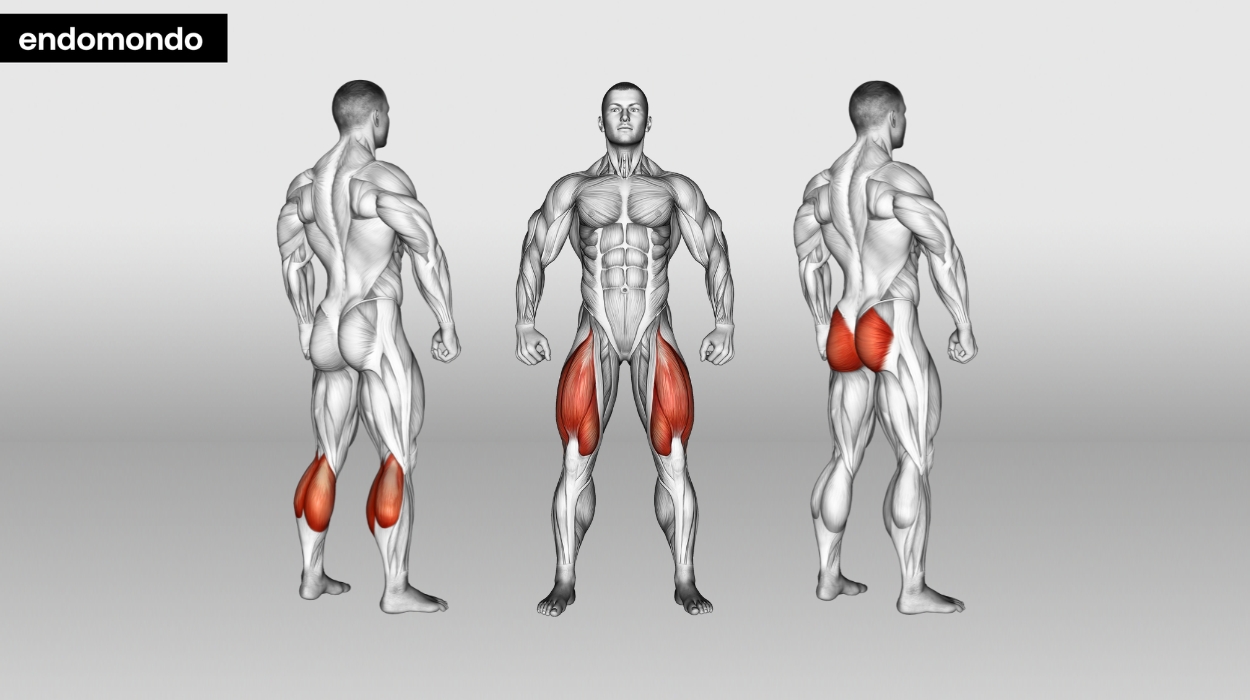
The Hack Squat exercise activates three main muscles[2] of the lower body which are highlighted below.
Upward Phase (Leg Pressing Up)
- Calf Muscles.
- Quadriceps.
- Gluteus Maximus.
Downwards Phase (Squatting Down)
- Gluteus Maximus.
- Calf Muscles.
The Most Common Hack Squat Mistakes To Avoid
Squatting Past Depth
A common misconception amongst intermediate gym goers is everyone must perform deep hack squats, for every rep, set, and workout. Without a doubt, these deep hack squats may stimulate more muscle fibers in the lower body.
For others who do not possess adequate flexibility, there is always a risk of overstretching, with subsequent soft tissue injuries (i.e. Quadriceps tendons rupture).
Overloading The Hack Squat
Beginners and intermediate gym goers are often guilty of overloading the hack squat exercise. This increases the risk of injury, or poor range of motion to the point that the quadriceps are hardly working. In reality, this is nothing but an ego lift.
Some professional bodybuilders have racked up over 700 lbs, only to rupture both quadriceps tendons completely.
Bouncing Off The Momentum
The Hack squat workout can build up eccentric energy during the downward phase. Without realizing it, many lifters use this momentum[3] with the elastic energy of their tendons to bounce the weight back up. This bounce mechanism may help to condition the tendons, but unfortunately heists the tensile stimulus from the lower body.
To avoid this mistake, pause at the bottom of the movement for one to two seconds. This simple alteration could neutralize the downward energy of the lift, and engage the muscles more.
What About The Hamstring Muscle Groups?
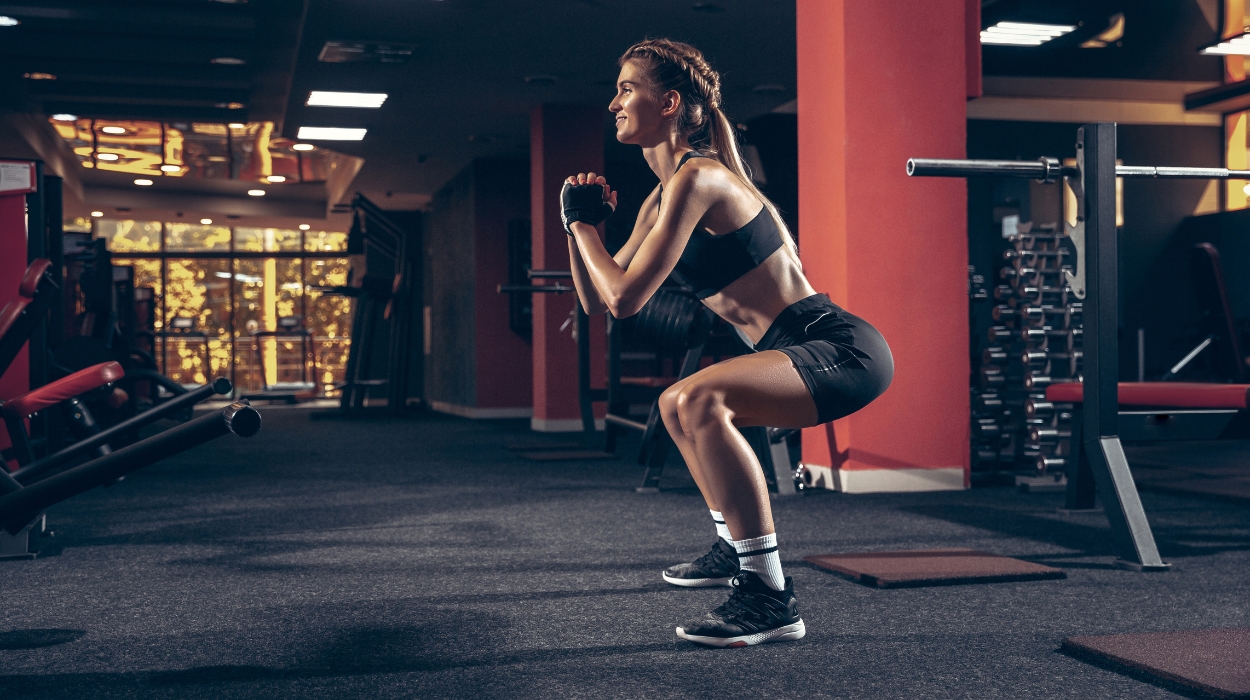
Contrary to common belief, squats have minimal activation to the hamstrings. During the upward motion of the squat, the hamstrings are counteracted.[2] This is because they shorten at the hip, but lengthen at the knee.
A 10-week squat-based study by Kubo and colleagues detected an increase in muscle volume[2] of up to 7.5% in the quadriceps, and up to 8.8% in the glutes. They claim there was no change in the hamstring muscle group according to the MRI.
In simple words, the hamstrings are constantly being stretched and squashed throughout the movement; so they do not get the chance to work.
Is There Anyone Who Should Skip It?
For anyone who is prone to knee extensor injuries or has an existing knee condition (i.e., ACL pain or sprain), the best option would be to avoid this exercise.
Why so?
The Hack squat places a lot of tension on straightening your knee which requires many tissues that facilitate the movement. The last thing you would want is a lower leg injury.
Conclusion
Hack squats are a great alternative to conventional Barbell squats. The Hack squat works the lower body, emphasizing the quadriceps, but nullifying the hamstrings. It also has an element of sports transferability from its kinetic chain.
If hack squat is not for you, alternative exercises are mentioned to include in your workout routine.
Avoid these hack squat mistakes: taking on depths beyond your capabilities, overloading the sleeves, and bouncing at the bottom of the movement.
Last but not least, those prone to knee extensor injuries could avoid this exercise.
Frequently Asked Questions
I wouldn’t say ‘best’ but it sure is a great exercise for targeting the quadriceps and other areas of the lower body.
Commonly, those with weaker quadriceps may struggle, as the hack squat puts a greater demand on this area. However, there could be other reasons why you struggle, which would require individualized analyses.
Resources
- Deniz, E. and Yavuz Hasan Ulas (2019). Evaluation of Muscle Activities During Different Squat Variations Using Electromyography Signals. Advances in intelligent systems and computing, [online] pp.859–865. doi:https://doi.org/10.1007/978-3-030-35249-3_114.
- Kubo, K., Toshihiro Ikebukuro and Yata, H. (2019). Effects of squat training with different depths on lower limb muscle volumes. European journal of applied physiology (Print), [online] 119(9), pp.1933–1942. doi:https://doi.org/10.1007/s00421-019-04181-y.
- Bas Van Hooren and Zolotarjova, J. (2017). The Difference Between Countermovement and Squat Jump Performances: A Review of Underlying Mechanisms With Practical Applications. Journal of strength and conditioning research, [online] 31(7), pp.2011–2020. doi:https://doi.org/10.1519/jsc.0000000000001913.




